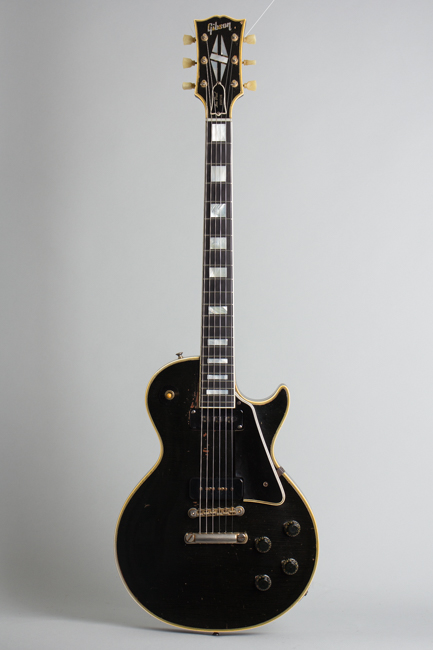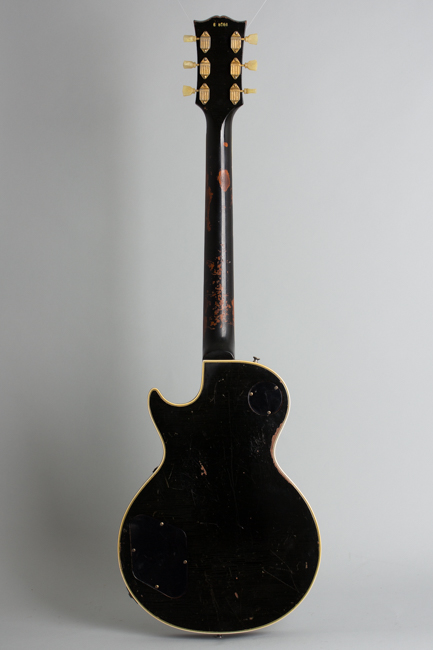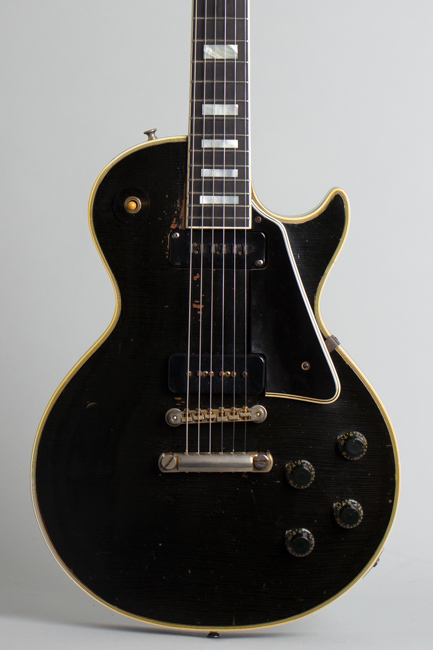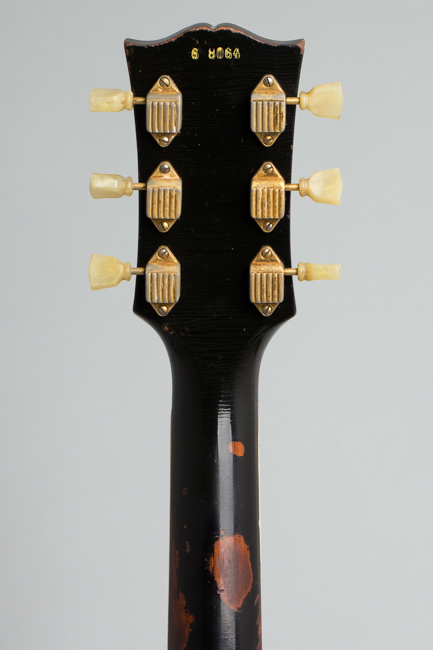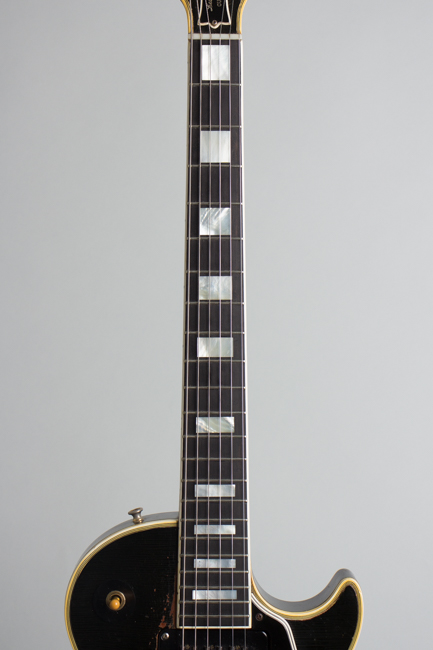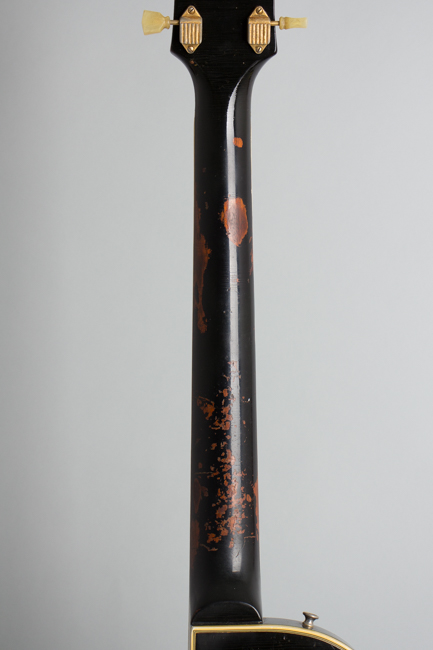Gibson Les Paul Custom Solid Body Electric Guitar (1956)
This item has been sold.
Item # 12194
Prices subject to change without notice.
Gibson Les Paul Custom Model Solid Body Electric Guitar (1956), made in Kalamazoo, Michigan, serial # 6-8064, black lacquer finish, mahogany body and neck, ebony fingerboard, black tolex hard shell case.
This is a seriously cool "real relic" 1956 Les Paul Custom, showing a decent amount of play wear but with some wonderful materials from the original owner that highlighting its history. The Custom was Gibson's top-of-the-line solid-body throughout the 1950s, a shining "Black Beauty" with gold-plated hardware and deluxe appointments drawn from the company's flagship archtops. This model was introduced in 1954 with direct input from Les Paul himself as to what he wanted his personal instruments to be. Gibson delivered, and Les and Mary Ford performed for the rest of the 1950s on (modified) Customs. This one was made in 1956 and shows some typical wear from professional use but remains unaltered.
The gleaming black finish was Les' idea -- he called it a "tuxedo effect" believing it made the player's hands stand out especially on black & white TV. The Custom has several other unique features. The carved-top solid body is made entirely of mahogany; unlike the Standard model it has no maple cap. This was not Les' specification, and while he later claimed Gibson had "screwed it up," this does give the Custom a slightly warmer, airier natural sound which Gibson thought might appeal to jazz artists.
The appointments are high-end; the fretboard is ebony with pearl block inlay and the elaborate split diamond motif on the headstock came from the Super 400, Gibson's most expensive guitar. There is multiple binding in the body and headstock and all hardware is gold-plated. Another feature specific to the Custom was thin, low and flat "Fretless Wonder" fretwire, again Les' personal preference. Like most this Custom has been neatly refretted with more functional wire and is far more friendly to nearly all players as a result.
The Custom was the first to feature Gibson's then-new adjustable Tune-O-Matic bridge, mated to the stud-mounted stop tailpiece unit that had previously served as the bridge on the Standard and Junior. It was the only solid-body to carry the new "Alnico V" staple-magnet pickup designed for the company's high-end instruments, again likely with input from Les himself. This is essentially Gibson's take on a DeArmond DynaSonic, which is what Les mounted in the neck position of in his personal Standard in 1953-4. Combined with the more typical P-90 in the bridge position, this crisp and powerful pickup gives the Custom a wide tonal range unique among Gibson solid-bodies.
In 1957 the Les Paul Custom was altered to feature three of the new Humbucking pickups, and the unique Alnico V/P-90 pickup mix was lost. Only around 1,000 of these first generation Customs were sold between late 1954 and mid-1957. Several well-known players made extensive use of them at the time including R&B/Jazz specialist Mickey Baker and Bill Haley's Comets' guitarist Frannie Beecher.
This well-used Custom has a great backstory: it was originally purchased with a set of instruments for upstate New York traveling group the Lytle Family, who played around the northeast and had a local TV show from 1955-65. It was played by one of the daughters, Betty Jean for many years. Includes with the instrument are the original sales contract from 1957, a lovely business card illustrating the band in action and a letter from Betty Jean's husband detailing this history. Amazingly enough this guitar was the least expensive piece at $407.00. The others are a Gretsch hi-Fi amp for $497 and the Excelsior accordion was a whopping $1440! It took the family nearly 3 years to pay off the debt. The letter states the guitar "had a good life" and we can only add it has plenty of life left in it, one of the classiest and sharpest looking solid-body guitars ever designed and a unique sounding one as well.
Overall length is 39 5/8 in. (100.6 cm.), 13 in. (33 cm.) wide at lower bout, and 2 in. (5.1 cm.) in depth, measured at side of rim. Scale length is 24 3/4 in. (629 mm.). Width of nut is 1 11/16 in. (43 mm.)., 9.05 lbs.
This is a worn in but nicely original guitar overall, showing typical wear but nothing tragic for 68 years on the planet, well played in over many years but never abused. There are no visible repairs and the only alteration it the almost obligatory refret. The ebony finish is nicely weathered showing typical lateral checking and scratches, dents and dings, some through to the wood most heavily on the edges. The back of the body has areas of belt-buckle wear mostly into but not fully through the lacquer. The face has isolated pickwear with chipping and flaking above the fingerboard and between the pickups, but less armwear than many.
The back of the neck has some wear to the wood mostly behind the 3rd-6th fret area. The area from the 7th fret to the heel shows some fairly heavy random dings and chips through the finish for reasons lost to history. There is heavier checking on the headstock face; the lacquer has flaked off most of the pearl inlay and some smaller spots in the black areas. On the headstock rear there is noticeable lateral checking but the original inked-on gold serial number is fully intact.
The hardware remains original and complete, even the fragile laminated plastic jackplate which has a couple of cracks but is still functional. There is typical wear to the gold plating as usual most heavily on the ends of the bridge and stop tailpiece where it is almost completely worn away. The screw retaining the pickguard to the bracket is ancient but not original. The electronics appear original including the pickups, switch, pots, wiring and caps. There is some wear to the neck pickup cover and the amber switch tip is a repro.
The wire used for the refret is slightly larger and taller Gibson's 1950s standard and the guitar is an excellent player as a result. They show virtually no wear since installation, the ebony fingerboard is clean and the bone nut appears original. On the whole this is a very nice player's examples of a 1950s Les Paul Custom, used but not abused with a great backstory. Both pickups have plenty of sing and the instrument offers a very powerful sound both clean and cranked. It comes in a later (1970s) purple-lined black case, fairly well worn with the fabulous original picture card, sales contract and letter documenting this Black Beauty's wonderful history. Overall Very Good + Condition.
This is a seriously cool "real relic" 1956 Les Paul Custom, showing a decent amount of play wear but with some wonderful materials from the original owner that highlighting its history. The Custom was Gibson's top-of-the-line solid-body throughout the 1950s, a shining "Black Beauty" with gold-plated hardware and deluxe appointments drawn from the company's flagship archtops. This model was introduced in 1954 with direct input from Les Paul himself as to what he wanted his personal instruments to be. Gibson delivered, and Les and Mary Ford performed for the rest of the 1950s on (modified) Customs. This one was made in 1956 and shows some typical wear from professional use but remains unaltered.
The gleaming black finish was Les' idea -- he called it a "tuxedo effect" believing it made the player's hands stand out especially on black & white TV. The Custom has several other unique features. The carved-top solid body is made entirely of mahogany; unlike the Standard model it has no maple cap. This was not Les' specification, and while he later claimed Gibson had "screwed it up," this does give the Custom a slightly warmer, airier natural sound which Gibson thought might appeal to jazz artists.
The appointments are high-end; the fretboard is ebony with pearl block inlay and the elaborate split diamond motif on the headstock came from the Super 400, Gibson's most expensive guitar. There is multiple binding in the body and headstock and all hardware is gold-plated. Another feature specific to the Custom was thin, low and flat "Fretless Wonder" fretwire, again Les' personal preference. Like most this Custom has been neatly refretted with more functional wire and is far more friendly to nearly all players as a result.
The Custom was the first to feature Gibson's then-new adjustable Tune-O-Matic bridge, mated to the stud-mounted stop tailpiece unit that had previously served as the bridge on the Standard and Junior. It was the only solid-body to carry the new "Alnico V" staple-magnet pickup designed for the company's high-end instruments, again likely with input from Les himself. This is essentially Gibson's take on a DeArmond DynaSonic, which is what Les mounted in the neck position of in his personal Standard in 1953-4. Combined with the more typical P-90 in the bridge position, this crisp and powerful pickup gives the Custom a wide tonal range unique among Gibson solid-bodies.
In 1957 the Les Paul Custom was altered to feature three of the new Humbucking pickups, and the unique Alnico V/P-90 pickup mix was lost. Only around 1,000 of these first generation Customs were sold between late 1954 and mid-1957. Several well-known players made extensive use of them at the time including R&B/Jazz specialist Mickey Baker and Bill Haley's Comets' guitarist Frannie Beecher.
This well-used Custom has a great backstory: it was originally purchased with a set of instruments for upstate New York traveling group the Lytle Family, who played around the northeast and had a local TV show from 1955-65. It was played by one of the daughters, Betty Jean for many years. Includes with the instrument are the original sales contract from 1957, a lovely business card illustrating the band in action and a letter from Betty Jean's husband detailing this history. Amazingly enough this guitar was the least expensive piece at $407.00. The others are a Gretsch hi-Fi amp for $497 and the Excelsior accordion was a whopping $1440! It took the family nearly 3 years to pay off the debt. The letter states the guitar "had a good life" and we can only add it has plenty of life left in it, one of the classiest and sharpest looking solid-body guitars ever designed and a unique sounding one as well.
Overall length is 39 5/8 in. (100.6 cm.), 13 in. (33 cm.) wide at lower bout, and 2 in. (5.1 cm.) in depth, measured at side of rim. Scale length is 24 3/4 in. (629 mm.). Width of nut is 1 11/16 in. (43 mm.)., 9.05 lbs.
This is a worn in but nicely original guitar overall, showing typical wear but nothing tragic for 68 years on the planet, well played in over many years but never abused. There are no visible repairs and the only alteration it the almost obligatory refret. The ebony finish is nicely weathered showing typical lateral checking and scratches, dents and dings, some through to the wood most heavily on the edges. The back of the body has areas of belt-buckle wear mostly into but not fully through the lacquer. The face has isolated pickwear with chipping and flaking above the fingerboard and between the pickups, but less armwear than many.
The back of the neck has some wear to the wood mostly behind the 3rd-6th fret area. The area from the 7th fret to the heel shows some fairly heavy random dings and chips through the finish for reasons lost to history. There is heavier checking on the headstock face; the lacquer has flaked off most of the pearl inlay and some smaller spots in the black areas. On the headstock rear there is noticeable lateral checking but the original inked-on gold serial number is fully intact.
The hardware remains original and complete, even the fragile laminated plastic jackplate which has a couple of cracks but is still functional. There is typical wear to the gold plating as usual most heavily on the ends of the bridge and stop tailpiece where it is almost completely worn away. The screw retaining the pickguard to the bracket is ancient but not original. The electronics appear original including the pickups, switch, pots, wiring and caps. There is some wear to the neck pickup cover and the amber switch tip is a repro.
The wire used for the refret is slightly larger and taller Gibson's 1950s standard and the guitar is an excellent player as a result. They show virtually no wear since installation, the ebony fingerboard is clean and the bone nut appears original. On the whole this is a very nice player's examples of a 1950s Les Paul Custom, used but not abused with a great backstory. Both pickups have plenty of sing and the instrument offers a very powerful sound both clean and cranked. It comes in a later (1970s) purple-lined black case, fairly well worn with the fabulous original picture card, sales contract and letter documenting this Black Beauty's wonderful history. Overall Very Good + Condition.
